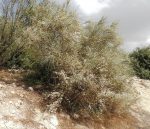 This dense, deciduous, flowering shrub is native to arid regions of northern Africa from the Western Sahara to Sudan, Sicily, the Sinai Peninsula, the Palestine region and Saudi Arabia. It belongs to the pea family, Fabaceae, that also includes lupines, black locust and mimosa. Growing from a deep root, the shrub grows 10-20′ tall and has slender, green, drooping branches carrying .2″ long gray-green leaves that quickly fall so that photosynthesis is carried out primarily by the green stems. From late winter to early spring, dense racemes of 3-15 fragrant, white flowers appear close to the stem. Each flowers is 1″ across and has banner, wing, and keel petals typical of the pea family. The seed pod is indehiscent and contain one or two seeds. The shrub is deer resistant and tolerant of heat and drought. It is grown as an ornamental in Mediterranean climates and is harvested from the wild for local use as medicine and a source of fuel. It is especially valued for making charcoal. Fruits and flowers provide forage for goats. The genus name, Retama, is the Latinized form of the Arabic name for the plant, and refers to a string tied around a finger as a reminder. The specific epithet, raetam, is derived from Hebrew רְתֹם (retom) meaning to bind.Type: Deciduous flowering shrub
This dense, deciduous, flowering shrub is native to arid regions of northern Africa from the Western Sahara to Sudan, Sicily, the Sinai Peninsula, the Palestine region and Saudi Arabia. It belongs to the pea family, Fabaceae, that also includes lupines, black locust and mimosa. Growing from a deep root, the shrub grows 10-20′ tall and has slender, green, drooping branches carrying .2″ long gray-green leaves that quickly fall so that photosynthesis is carried out primarily by the green stems. From late winter to early spring, dense racemes of 3-15 fragrant, white flowers appear close to the stem. Each flowers is 1″ across and has banner, wing, and keel petals typical of the pea family. The seed pod is indehiscent and contain one or two seeds. The shrub is deer resistant and tolerant of heat and drought. It is grown as an ornamental in Mediterranean climates and is harvested from the wild for local use as medicine and a source of fuel. It is especially valued for making charcoal. Fruits and flowers provide forage for goats. The genus name, Retama, is the Latinized form of the Arabic name for the plant, and refers to a string tied around a finger as a reminder. The specific epithet, raetam, is derived from Hebrew רְתֹם (retom) meaning to bind.Type: Deciduous flowering shrub
Outstanding Feature: Weeping form; flowers
Form: Weeping
Growth Rate: Moderate
Bloom: Racemes of white pea-like flowers from late winter to early spring
Size: 10-20′ H
Light: Full sun
Soil: Sandy, lean, dry, well-drained
Hardiness: Zones 9-10
Care: Low maintence; protect from rain in winter.
Pests and Diseases: Unavailable
Propagation: Seed
Outstanding Selections: None
Photo Credit: Peter Coxhead Wikipedia.